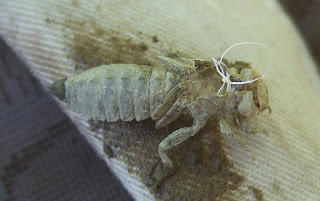In 2014, the process began in Michigan to review the
T & E species.
Gray Petaltail (Tachopteryx thoreyi) is one species included on the list. With less than a handful of specimens and a few known historical locations, this year I have decided to check for presence in SW Michigan counties. (note: This species is protected in Michigan and cannot be collected without a special permit)
To save time during the flight season, I scouted a few locations in
Cass and
St. Joseph counties on April 4, 2015. I found this Maryland website that describes the
species' habitat.
Lawless Park, Cass County
It had been suggested to check
Dr. T. K. Lawless Park since it has forested hills with seeps. I walked a good portion of the
trails (1, 2, 3, 4, 5, and a portion of 7).
Trail #5 is a nice hike but the west end that used to be farmland is overrun by non-native, invasive plants. There are a couple of streams that may hold some interested odes:
Trails # 4 and 7 appeared to have the most appropriate petaltail habitat.
Seeps from the hill above trail #4 contributed to the wetland at the base:
The open beech-maple forest makes for a pleasant walk:
I didn't walk all of trail #7, but I would guess there would be potential habitat in the southwest area of trail, up to Lewis Lake Road.
Three Rivers SGA, Cass/St. Joseph Counties
I had visited Wood Creek in the Cass County portion of the
state game area last year since one petaltail record was from this section.
MNFI performed surveys of this area in 2009 and
this report is worth reviewing.
 |
| Wood Creek |
The habitat at the creek crossing isn't right for breeding petaltails, but there were a number of other species including a significant find. (to be covered in a future post) I looked for other access points to hillsides from the Cass County area and it was too overgrown with buckthorn and honeysuckle for "easy" access. Then a thunderstorm arrived and finished my partial day of exploring. Before visiting this spring, I checked topographic maps and satellite images for possible hillsides with access on the St. Joseph County side.
Purgatory Road seemed to get closest to areas with potential habitat. Access from the road areas is a bit difficult due to thick areas of non-native, invasive buckthorns and honeysuckles, but after bushwhacking through the thickets, the woods open up significantly. The hillsides had some seeps and the lower areas included wooded wetlands and Mill Creek.
Approximately 3/4 mile in from the road, there were large areas that appeared to have potential for petaltails. Getting back here with a net in June will be on the agenda.
 |
| between Mill Creek and Purgatory Road |
Mill Creek at Preston Road appears to be a promising area with the easiest accessibility. The bridge area has parking and there are hillside seeps within a couple hundred meters of the road.
 |
| Mill Creek at Preston Road |
Curtis Creek (aka Profile Lake Drain) at Preston Road was interesting also as it has fairly easy access to the water. It may not have good petaltail habitat nearby, but there are likely a variety of other odes.
 |
| Curtis Creek, aka Profile Lake Drain |
The most interesting insect on this early date was found on a dead raccoon. There were 14+ Margined Carrion Beetles (
Oiceoptoma noveboracense) swarming around this carcass.
 |
| Margined Carrion Beetles (Oiceoptoma noveboracense) |
This scouting trip was successful for finding accessible locations to revisit in late June. Hopefully, we'll have another post in June/July noting success in finding flying Gray Petailtails (
T. thoreyi) for additional locations than previously recorded.





















































